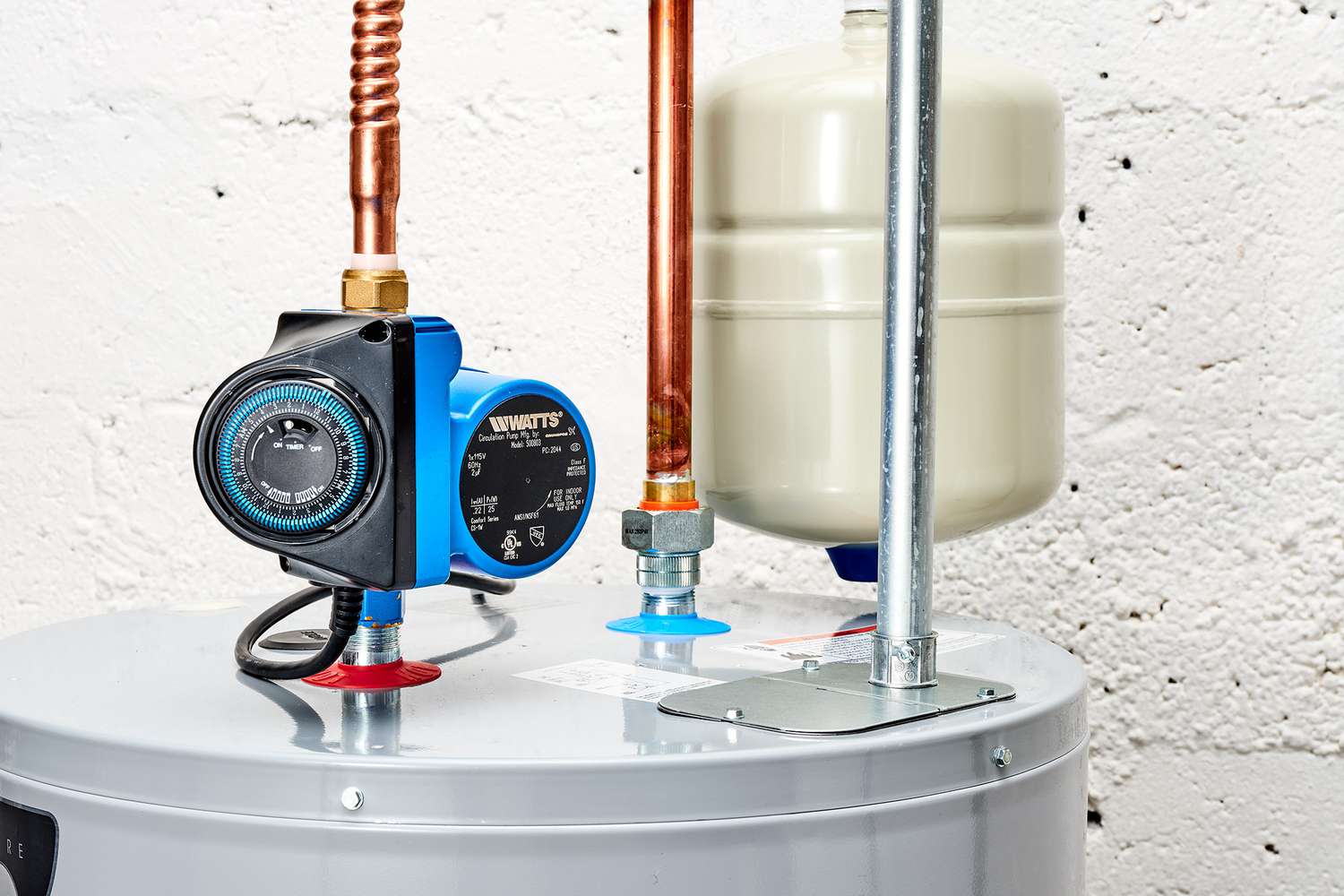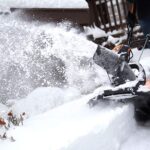Table of Contents
What is a Hot Water Recirculating Pump?
A hot water circulation pump is a plumbing system addition designed to provide instant hot water at faucets and showers. It works by circulating hot water through a home’s hot water pipes, reducing the amount of time required for hot water to travel from the water heater to distant faucets and showers.
Without a hot water circulation pump, water sitting idle in the pipes slowly loses heat. This means you have to wait for the cooled-off water to clear the pipes before hot water arrives when turning on a faucet or shower. The hot water circulation pump constantly moves hot water through the plumbing system so you don’t have to wait for hot water.
The pump is installed on the hot water line near the water heater and uses a dedicated return line to circulate hot water back to the heater. When activated, the pump draws hot water from the hot water pipe through the return line, creating a continuous loop through the plumbing system that keeps hot water primed at the faucet. This provides instant hot water with the turn of a faucet, eliminating long waits.
Benefits of a Hot Water Recirculating Pump
A hot water circulation pump provides several benefits compared to a standard water heating system without a pump. The main benefits include:
- Saves water by reducing wait time for hot water – One of the biggest advantages of a hot water circulation pump is reducing water waste while waiting for hot water to reach your faucet or shower. Without a pump, you may have to run gallons of water down the drain while waiting for hot water to travel from the water heater to the fixture. A recirculating pump continually circulates hot water through the pipes, meaning you get hot water instantly without any waste.
- More convenient and comfortable by providing instant hot water – Waiting for hot water can be an annoying daily inconvenience. With a hot water circulation pump, you don’t have to wait any longer. Turn on the tap and enjoy an instant flow of hot water. This makes tasks like washing hands, doing dishes, and showering more comfortable and convenient.
- Can help lower water heating costs – By reducing wasted water, a hot water circulation pump can also help lower your energy costs for heating water. You’ll spend less to reheat all of that cold water running down the drain while waiting for hot water. Installing a pump ensures you are only heating the water you actually use.
How a Hot Water circulation Pump Works
A hot water circulation pump works by circulating cold water from the hot water lines back to the water heater to be reheated. This creates a loop that keeps hot water primed in the pipes, so you don’t have to wait for hot water.
The pump is installed under the sink furthest away from the water heater. It draws cold water from the hot water line through a dedicated return line that runs back to the water heater.
The pump cycles cold water through this loop, keeping hot water primed in the pipes. This eliminates the need to wait for hot water when turning on a faucet or shower.
Many hot water circulation pump have built-in timers or temperature sensors to control operation. A timer can turn the pump on during peak water usage hours and off at night. A temperature sensor activates the pump when the return line water drops below a set temperature.
Some hot water circulation pumps feature demand controls. These detect when a hot water faucet is opened, triggering the pump to switch on. Once the faucet is closed, the pump shuts off again. This provides hot water on demand without wasting energy circulating water when not needed.
Hot water circulation pump controls help maximize energy efficiency. Running the pump only when necessary helps minimize standby heat loss in the pipes while still providing instant hot water delivery.
Types of Hot Water Recirculating Pumps
There are several types of pumps that can be used in hot water circulation pump systems. The most common are:
Centrifugal Pumps
Centrifugal pumps are one of the most widely used types of pumps in hot water circulation pump. They work by spinning water inside the pump to create pressure.
Pros:
- Relatively inexpensive
- Simple design with just one moving part makes them reliable and easy to maintain
- Can handle hot water temperatures up to 200°F
- Well-suited for low pressure hot water circulation pump systems
Cons:
- Less efficient at high pressures
- Can be noisy
- Higher flow rates may require multiple pumps
Turbine Pumps
Turbine pumps use a rotating turbine to impart velocity to the water. The kinetic energy created pressurizes the water.
Pros:
- Excellent for high flow and high pressure systems
- Run smoothly and quietly
- Durable construction
Cons:
- More expensive than centrifugal pumps
- Can be damaged by debris in the water
- Require more maintenance
Positive Displacement Pumps
Positive displacement pumps use a mechanism to physically displace water, building up pressure. Common types are piston and diaphragm pumps.
Pros:
- Can generate very high pressures
- Some models are self-priming
- Good efficiency
Cons:
- Can be expensive
- Pulsating flow
- Prone to wear and need frequent maintenance
Choosing a Pump Type
The type of hot water circulation pump best suited depends on the flow rate and pressure requirements of the system. Centrifugal pumps are a good choice for typical residential hot water circulation pump. Turbine and positive displacement pumps are used for high-pressure applications.
Sizing and Selecting a Hot Water Recirculating Pump
Choosing the right size hot water recirculating pump for your home is important to ensure it operates efficiently. The main factors to consider are:
- Pipe Length – The length of pipe the water has to circulate through affects the pump size needed. Longer pipe runs require a more powerful pump to push the water through. Measure your total pipe length from the water heater to the furthest faucet.
- Pump Height – Pumps have to work against gravity to push water upwards. If your pump is located below the water heater, more power is needed to lift the water. Consider the vertical distance the pump must push water.
- Flow Rate – The flow rate, measured in GPM (gallons per minute), indicates the pump’s capacity. Larger homes need a higher GPM to circulate water quickly. Choose a pump that matches your required flow rate.
- Home Size – Consider the number of bathrooms, fixtures, and water demand. Larger homes need more powerful pumps.
- Pipe Size – The diameter of your pipes also impacts pump size. Narrower pipes increase friction and restrict flow, requiring a larger pump.
Determine your required flow rate based on home size and fixtures. Next, factor in pipe length and height. Use pump sizing charts to select a model that matches your parameters. Oversizing the pump wastes energy, while undersizing causes slow water circulation. Consult a sizing guide or plumbing professional to choose the right pump. Proper sizing saves energy and delivers optimal hot water recirculation.
Installation and Maintenance
Properly installing and maintaining a hot water recirculating pump is key to ensuring it operates efficiently and has a long service life. Here are some tips:
Installation
- Install the pump as close as possible to the water heater to minimize the length of the return line. This improves efficiency.
- The supply and return lines should be insulated to retain heat. Use at least R-4 insulation on the pipes.
- Install a dedicated electrical circuit and outlet for the pump. It should be GFCI protected. Follow all local electrical codes.
- Mount the pump vertically to allow air bubbles to escape and prevent cavitation noise.
- Install unions on both sides of the pump to make service and replacement easier.
- Install check valves on both lines to ensure water only flows in the intended direction.
- Flush the plumbing lines before connecting the pump to remove debris.
Maintenance
- Clean the pump strainer periodically to remove sediment and debris.
- Lubricate the pump motor according to manufacturer specifications, often annually.
- Replace the pump every 5-7 years or if noise and performance degrade.
- Inspect supply and return lines annually for leaks and insulation integrity. Repair as needed.
- Flush the plumbing system regularly to remove scale buildup and ensure peak performance.
Proper installation and ongoing maintenance will help the hot water recirculating pump provide years of reliable service and energy savings. Follow manufacturer guidelines for any model specific care and maintenance steps.
Cost of a Hot Water Recirculating Pump
Hot water recirculating pumps require an initial equipment and installation cost, but can save money over time by reducing water waste and energy usage. Here are some typical costs to consider:
- Pump – $150 to $300 depending on type, size and features. More expensive models tend to be quieter, more durable and energy efficient.
- Installation – $200 to $500 for a plumber to install the pump and connect plumbing. Cost depends on home layout and complexity.
- Timer or sensor – $50 to $100 for a control to activate the pump based on usage patterns. Can further optimize energy savings.
- Pipe insulation – $1 to $2 per linear foot to prevent heat loss in the recirculation loop.
- Energy usage – Recirculating pumps use about 15-25 watts when running, costing $3 to $5 per month to operate. This is easily offset by hot water savings.
The upfront equipment and installation costs for a hot water recirculating pump typically range from $500 to $1000. With energy savings of $200 or more per year, the simple payback is less than 5 years in most homes. Reduced water usage provides additional long-term cost savings on water and sewer bills.
For a relatively low initial investment, a hot water recirculating pump can pay for itself in energy and water savings within a short time. The pump continues providing hot water convenience and utility savings each month after it is paid off. This makes it a cost-effective upgrade that provides better comfort and efficiency.
Energy Savings from a Hot Water Recirculating Pump
Installing a hot water recirculating pump can provide significant water and energy savings in most homes. By circulating hot water through the plumbing system, you avoid having to run as much water down the drain while waiting for hot water to reach your faucet or shower. This saves water, and also reduces the amount of energy needed to heat replacement water.
Estimates of savings vary based on several factors:
- Home size and length of plumbing runs – Longer distances from the water heater to fixtures result in more potential savings. Large homes with multiple bathrooms far from the water heater benefit the most.
- Insulation – Well insulated hot water lines will lose less heat as water circulates. This increases savings. Poorly insulated plumbing will lose more heat and decrease savings.
- Number of occupants and hot water usage – The more hot water used, and the more times fixtures are turned on and off, the more potential savings.
- Cost of water and energy – Higher utility costs mean greater savings from reduced water and energy usage.
- Pump efficiency – More efficient pump models save more energy for circulating hot water.
Most sources estimate a hot water recirculating pump can save the average household 2000-5000 gallons of water per year, reducing water heating costs by $100 or more annually. With the right conditions, some achieve savings up to 30% on their water heating bills.
Pros and Cons of a Hot Water Recirculating Pump
A hot water recirculating pump can provide several benefits but also has some downsides to consider. Here is a summary of the main pros and cons:
Pros:
- Provides instant hot water at fixtures, eliminating long wait times
- Conserves water by eliminating need to flush cold water while waiting for hot
- Can reduce water heating costs by recirculating already hot water rather than letting it cool in pipes
- More convenient and comfortable to have hot water immediately available
- Can increase home resale value by having instant hot water
Cons:
- Adds upfront equipment and installation costs
- Ongoing energy costs to run the recirculation pump
- Can increase water heating costs depending on home size and pump run times
- Requires cutting into existing plumbing to install return line
- More parts that can fail over time
Overall, a recirculating pump makes the most sense in larger homes with long pipe runs, where the wait for hot water is very long. The upfront costs can usually be recouped over time from water savings. In smaller homes with short pipe runs, the costs may outweigh the benefits. Consider your needs and do a cost analysis before deciding.
Hot Water Recirculating Pump Recommendations
When choosing a hot water recirculating pump, it’s important to select a reliable brand and model suited to your home’s needs. Based on consumer reviews and expert recommendations, here are some top pumps to consider:
Grundfos 59896155 Comfort Series Recirculating Pump
- Energy efficient and quiet operation. Uses only 5-7 watts of power.
- Bronze and stainless steel construction. Corrosion-resistant.
- Built-in timer allows scheduling pump operation.
- Well-reviewed and recommended. Grundfos is a leading pump brand.
Laing LHB08100092 AutoCirc Recirculating Pump
- 1/12 HP pump with built-in timer and temperature sensor.
- Adjustable activation based on hot water return temperature.
- Quiet operation and very energy efficient.
- Sturdy stainless steel and bronze housing.
Watts 500800 Hot Water Recirculating System
- Complete kit contains pump, built-in digital timer, and thermostatic valve.
- Activation based on water temperature for efficiency.
- Easy to install and set up. All parts included.
- Durable cast iron and bronze construction.
When selecting a recirculation pump, match the pump capacity to your home’s size and hot water demands. Opt for an energy efficient, quiet model with a built-in timer to control activation. Quality construction like bronze and stainless steel will ensure longevity. Review consumer reports and look for reliable brands like Grundfos, Laing, and Watts. Consider a complete kit for easiest installation.



